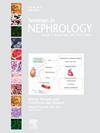James D Odum, Denise C Hasson, Natalja L Stanski, Hernando Gómez, Danielle E Soranno
下载PDF
{"title":"The Clinical View of Sepsis-Associated AKI: How Basic Science Can Help Solve This Problem.","authors":"James D Odum, Denise C Hasson, Natalja L Stanski, Hernando Gómez, Danielle E Soranno","doi":"10.1016/j.semnephrol.2025.151665","DOIUrl":null,"url":null,"abstract":"<p><p>The global health impact of sepsis is difficult to understate. As a complication of sepsis, the development of sepsis-associated acute kidney injury (SA-AKI) significantly increases the risk of mortality. Although several epidemiological risk factors for SA-AKI are known, the heterogeneity of this syndrome-across patients, pathogens, and treatment responses-has hindered therapeutic innovation and contributed to persistently poor outcomes. Precision medicine offers a promising framework to address this complexity, yet a substantial translational gap remains between mechanistic insights from preclinical models and the therapeutic strategies used in clinical practice. To bridge this gap, researchers should consider aligning preclinical models with human sepsis and embrace SA-AKI heterogeneity to identify treatable, mechanistically informed subtypes (endotypes). These efforts could enable the development of personalized therapies aimed at reducing the burden of SA-AKI. Semin Nephrol 36:x-xx © 20XX Elsevier Inc. All rights reserved.</p>","PeriodicalId":21756,"journal":{"name":"Seminars in nephrology","volume":" ","pages":"151665"},"PeriodicalIF":3.5000,"publicationDate":"2025-09-10","publicationTypes":"Journal Article","fieldsOfStudy":null,"isOpenAccess":false,"openAccessPdf":"https://www.ncbi.nlm.nih.gov/pmc/articles/PMC12435906/pdf/","citationCount":"0","resultStr":null,"platform":"Semanticscholar","paperid":null,"PeriodicalName":"Seminars in nephrology","FirstCategoryId":"3","ListUrlMain":"https://doi.org/10.1016/j.semnephrol.2025.151665","RegionNum":3,"RegionCategory":"医学","ArticlePicture":[],"TitleCN":null,"AbstractTextCN":null,"PMCID":null,"EPubDate":"","PubModel":"","JCR":"Q2","JCRName":"UROLOGY & NEPHROLOGY","Score":null,"Total":0}
引用次数: 0
引用
批量引用
Abstract
The global health impact of sepsis is difficult to understate. As a complication of sepsis, the development of sepsis-associated acute kidney injury (SA-AKI) significantly increases the risk of mortality. Although several epidemiological risk factors for SA-AKI are known, the heterogeneity of this syndrome-across patients, pathogens, and treatment responses-has hindered therapeutic innovation and contributed to persistently poor outcomes. Precision medicine offers a promising framework to address this complexity, yet a substantial translational gap remains between mechanistic insights from preclinical models and the therapeutic strategies used in clinical practice. To bridge this gap, researchers should consider aligning preclinical models with human sepsis and embrace SA-AKI heterogeneity to identify treatable, mechanistically informed subtypes (endotypes). These efforts could enable the development of personalized therapies aimed at reducing the burden of SA-AKI. Semin Nephrol 36:x-xx © 20XX Elsevier Inc. All rights reserved.
败血症相关AKI的临床观点:基础科学如何帮助解决这一问题。
败血症对全球健康的影响难以低估。作为脓毒症的并发症,脓毒症相关急性肾损伤(SA-AKI)的发生显著增加了死亡风险。尽管已知SA-AKI的几个流行病学危险因素,但该综合征在患者、病原体和治疗反应方面的异质性阻碍了治疗创新,并导致了持续的不良结果。精准医学为解决这种复杂性提供了一个有希望的框架,然而,临床前模型的机制见解与临床实践中使用的治疗策略之间仍存在实质性的转化差距。为了弥补这一差距,研究人员应该考虑将临床前模型与人类脓毒症结合起来,并接受SA-AKI异质性,以确定可治疗的、机制知情的亚型(内源性)。这些努力可以促进个性化治疗的发展,旨在减轻SA-AKI的负担。Semin Nephrol 36:x-xx©20XX Elsevier Inc.。版权所有。
本文章由计算机程序翻译,如有差异,请以英文原文为准。

 求助内容:
求助内容: 应助结果提醒方式:
应助结果提醒方式:


